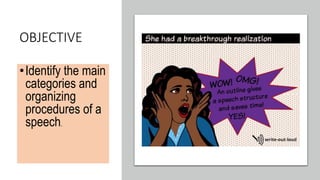
Speech delivery
- 1. OBJECTIVE •Identify the main categories and organizing procedures of a speech.
- 2. FIRST THINGS FIRST… • Before you begin writing your Outline or speech, you must consider three things: 1. What is your topic? 2. Whos is your audience for the speech? 3. What is the Purpose of your speech? What do you want to persuade, inform, inspire, entertain, your audience to believe after hearing your speech?
- 3. MAIN COMPONENTS Of A SPEECH • Leads & a conclusion • Thesis (Purpose) • At least three Supporting points for a thesis. • Address the audience at the beginning & throughout. • Organization of the speech • Use many persuasive techniques • Vary tone & speed of delivery • Make eye contact with the audience • Use correct grammar
- 4. LEAD PARAGRAPH • What is a lead? A lead paragraph involves three parts: 1. A Hook: Introduce yourself, acknowledge your audience, & create a hook about your topic that catches your audience attention. 2. Background info: Give background info about your topic. 3. Thesis: A Statement that clearly states your argument & what you are trying to persuade your audience to believe.
- 5. BODY PARAGRAPH • In the body you have paragraphs to support or prove the thesis that you’ve directly established in your lead. You always need three points to support your thesis. • For each point/paragraph always write a Supporting Statement for your thesis + PIE • P=Power with Logic: Facts, statistics, Expert testimony, etc. • I= Interprete the logic for your audience: Explain the logic & make it connect with your thesis. • E= Emotional Appeals: develop emotionanlly charged language to engage your audience.
- 6. BODY PARAGRAPH • To keep your audience engaged & able to easily follow your argument you should: • Use transitional words or phrases such as: “My first point”, “before I conclude”, “The third reason”, etc. • Words like “however”, and “although”also provide transitions. • Address the audience by name several times through the speech.
- 7. COUNTERPOINTS: • In persuasive writing, after the writer explains the three points, often addresses the counterpoints. • A Good writer anticipates what the other side of the issue would argue and addresses that. • The placement of counterpoints is flexible. They may appear inmediatelly after your lead paragraph.
- 8. CONCLUSION PARAGRAPH • Re-emphasizes the thesis or Purpose. This make your conclusion circle back to your thesis. • Call to action: Make it clear. • Leaves the audience thinking. • Speakers usually end the speech by thanking the audience for listening.
- 9. If your speech is effective it Will… • Establish your as a speaker on that topic (Ethos), use various persuasive techniques like , etc. • Make certain your audience understands: ₋ Where you stand on that topic. ₋ What you are asking your audience to believe. ₋ Why you believe your position is valid. ₋ What needs to be done about the topic. (call to action)
- 10. • Address the audience at the beginning. • Hook, or attention getter, make the audience want to listen to the rest of speech. • The three main points summary in Introduction are clear. • Each of the three main points should begin with transitional word or phrase. • It’s clear when one main point ends and the next begins. • Address your audience within the speech a couple of times. • Thanks the audience for listening.
- 18. • A persuasive speech is written to persuade, or to convince the listeners, of the validity of the speaker’s argument. • This might involve persuading someone to change their opinion or at the very least take into account some elements that have not really been considered before.
- 19. Informative Speech • An Informative speech is written to provide interesting & useful info to increase the knowledge of your audience. • It intends to educate the audience on a particular topic. • The aim of an informative speech is to help your audience to understand and to remember the information you are presenting. • This might involve providing info about a person, event, process, animal or an object.
- 20. Inspirational Speech • An Inspirational speech is written to persuade, or convince the listeners, that they can succeed. • This might involve relating optimistic and uplifting stories, or anecdotes, based on faith or real-life situations taken from the lives or ordinary or famous people from history, sports, politics and the Business world. • The objective of an inspirational speech is to provide the listener with the desire and confidence to pursue difficult goals to maximize their own potential.
- 21. Entertaining Speech • An entertaining speech is designed to captivate an audience’s attention and regale or amuse them while delivering a message. • Like more traditional informative or persuasive speeches, entertaining speeches should communicate a clear message, but the manner of speaking used is typically different. • Its purpose is not to educate, inform or inspire…it is to make the audience smile, relax, enjoy & maybe even laugh their heads off.
- 22. Speech Outline • Topic: Organizing public speeches • Specific Purpose Statement: To inform listeners about the various ways in which they can organize their public speeches. • Thesis Statement: A variety of organizational styles can be used to organize public speeches. • Introduction • Paragraph that gets the attention of the audience, establishes Good Will with the audience, states the purposed of the speech, and previews the speech and its structure. • (Transition)
- 23. Body I. Main point a. Sub-point b. Sub-point c. Sub-point i. Supporting point ii. Supporting point
- 24. (Transition) II. Main point a. Sub-point i. Supporting point 1. Example 2. Example ii. Supporting point b. Sub-point (Transition) Conclusion
- 26. Practice Take 10 min-time to prepare your Outline for your Informative, persuasive, inspirational or entertaining speech.
